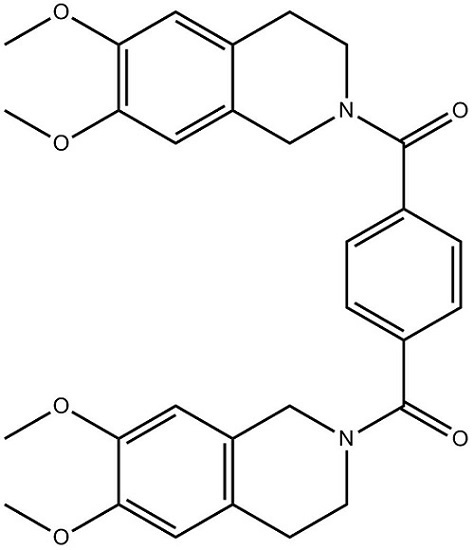1,4-Phenylenebis[(6,7-dimethoxy-3,4-dihydroisoquinolin-2(1H)-yl)methanone]
Abstract
:1. Introduction
2. Results
3. Materials and Methods
Synthesis of 1,4-Phenylenebis[(6,7-dimethoxy-3,4-dihydroisoquinolin-2(1H)-yl)methanone] 2
Supplementary materials
Acknowledgments
Author Contributions
Conflicts of Interest
References
- Kamlah, A.; Lirk, F.; Bracher, F. A new approach to 1-substituted β-carbolines and isoquinolines utilizing tributyl[(Z)-2-ethoxyvinyl]stannane as a C-3, C-4 building block. Tetrahedron 2016, 72, 837–845. [Google Scholar] [CrossRef]
- Kaur, M.; Sharma, S.; Bedi, P.M.S. Silica supported Brönsted acids as catalyst in organic transformations: A comprehensive review. Chin. J. Catal. 2015, 36, 520–549. [Google Scholar] [CrossRef]
- Liu, P.N.; Xia, F.; Wang, Q.W.; Ren, Y.J.; Chen, J.Q. Triflic acid adsorbed on silica gel as an efficient and recyclable catalyst for the addition of β-dicarbonyl compounds to alcohols and alkenes. Green Chem. 2010, 12, 1049–1055. [Google Scholar] [CrossRef]
- Saidov, A.S.; Levkovich, M.G.; Alimova, M.; Vinogradova, V.I. Synthesis of bis-tetrahydroisoquinolines based on homoveratrylamine and dibasic acids. 2. Chem. Nat. Compd. 2014, 49, 1099–1104. [Google Scholar] [CrossRef]
- Venkov, A.; Temnyalova, T.; Ivanov, I. Synthesis of N,N’-bis(1,2,3,4-tetrahydroisoquinolinyl) dicarboxamides by an intramolecular α-diamidoalkylation reaction. Synth. Commun. 1995, 25, 1419–1425. [Google Scholar] [CrossRef]
- Manolov, S.; Nikolova, S.; Ivanov, I. Silica-supported polyphosphoric acid in the synthesis of 4-substituted tetrahydroisoquinoline derivatives. Molecules 2013, 18, 1869–1880. [Google Scholar] [CrossRef] [PubMed]
- Kumar, D.; Sonawane, M.; Pujala, B.; Jain, V.K.; Bhagat, S.; Chakraborti, A.K. Supported protic acid-catalyzed synthesis of 2,3-disubstituted thiazolidin-4-ones: Enhancement of the catalytic potential of protic acid by adsorption on solid supports. Green Chem. 2013, 15, 2872–2884. [Google Scholar] [CrossRef]

© 2016 by the authors; licensee MDPI, Basel, Switzerland. This article is an open access article distributed under the terms and conditions of the Creative Commons Attribution (CC-BY) license (http://creativecommons.org/licenses/by/4.0/).
Share and Cite
Manolov, S.; Ivanov, I. 1,4-Phenylenebis[(6,7-dimethoxy-3,4-dihydroisoquinolin-2(1H)-yl)methanone]. Molbank 2016, 2016, M902. https://doi.org/10.3390/M902
Manolov S, Ivanov I. 1,4-Phenylenebis[(6,7-dimethoxy-3,4-dihydroisoquinolin-2(1H)-yl)methanone]. Molbank. 2016; 2016(3):M902. https://doi.org/10.3390/M902
Chicago/Turabian StyleManolov, Stanimir, and Iliyan Ivanov. 2016. "1,4-Phenylenebis[(6,7-dimethoxy-3,4-dihydroisoquinolin-2(1H)-yl)methanone]" Molbank 2016, no. 3: M902. https://doi.org/10.3390/M902







